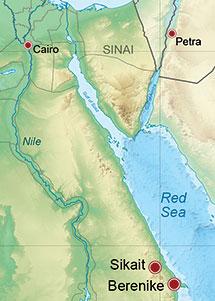Researchers in Berenike, Egypt, have discovered a 71-centimeter Buddha statue believed to date to the second century CE. An archaeological mission, led by American and Polish researchers, found a stone statue of the Buddha in the main early Roman period temple dedicated to the goddess Isis. The discovery provides new evidence of interaction between the ancient civilizations of India and Egypt.
The researchers believe that the statue was made in Alexandria. The halo or nimbus around the Buddha’s head, which represents his extraordinary nature, is uncommon as it features both a circular background and rays, “which indicates his radiant mind,” according to the Egyptian Ministry of Tourism and Antiquities. (Smithsonian Magazine)
The statue is missing part of its right side and its right leg.
Scottish historian and art historian William Dalrymple, based in Delhi, India, reported that the statue was carved from “the finest Mediterranean marble in a part Indian-Gandharan, part Romano-Egyptian style.” (Hyperallergic) Dalrymple noted the combination of the curls in the Buddha’s hair and the beaming sun rays behind his head
Mariusz Gwiazda, an archeologist from the University of Warsaw and leader of the Polish team working on the project, suggested that the stone for the statue could have been extracted from a region near Istanbul, while the statue itself may have been carved in Berenike and dedicated to the Isis temple by Indian merchants.
The Buddha statue has “important indications over the presence of trade ties between Egypt and India during the Roman era,” said the head of Egypt’s supreme antiquities council, Mostafa al-Waziri. (France 24)
Berenike, in southern Egypt on the coast of the Red Sea, was once a major seaport during the Roman-era, providing a landing site for ships from India carrying spices, textiles, stones, and ivory. The city remained a major trade hub for the Roman world, Egypt, sub-Saharan Africa, the Arabian peninsula, India, and beyond until the sixth century, when it was abandoned. Another artifact at the excavation contains an inscription in Sanskrit that has been dated to the middle of the third century CE, during the reign of Marcus Julius Philippus, known as Philip the Arab.
“You hear a lot about globalization today,” said historian Steve Sidebotham from the University of Delaware and director of the American team. “But there was a ‘global economy’ linking Europe, Africa, and Asia during the first century of the Christian era, and the city of Berenike is a perfect example of that.” (Smithsonian Magazine)
Scholars debate the extent to which Indian and Egyptian, Greek, and Roman thought might have influenced one another. Drawing on the similarities between Buddhist and Pyrrhonian thought—named for the Greek philosopher Pyrrho (360–270 BCE)—Georgios Halkias, professor of Buddhist Studies at the University of Hong Kong has suggested that Pyrrhonism could be considered a Buddhist tradition.
However, due to a lack of material evidence and ongoing scholarly debate, much of the extent of the interactions between these cultures remains unknown.
Of Berenike, Sidebotham said: “This is an amazing, huge site with excellent preservation because of the hyper-arid climate. We’ve probably uncovered only about 2 per cent of the ancient city, so there are still several lifetimes’ worth of work to be done.” (University of Delaware)
Read more
Archaeologists Unearth Buddha Statue in Ancient Egyptian Port City (Smithsonian Magazine)
Stone Buddha Found in Egypt Sheds Light on India’s Influence (Hyperallergic)
Buddha statue found in Egypt points to ancient India links (France 24)
Uncovering the secrets of Berenike (University of Delaware)
Related news reports from BDG
Gandharan Text at the US Library of Congress May Rewrite the History of Buddhism
Ethics Complaint about Gandharan Manuscripts Leads to Admonishment of Australian Academic
US Library of Congress Gives Glimpse into Early Buddhist Texts from Gandhara
British Museum to Return “Stunning” Gandharan Buddhist Artifacts to Afghanistan
Four Arrested in Pakistan for Destroying 1,700-year-old Buddha Statue














